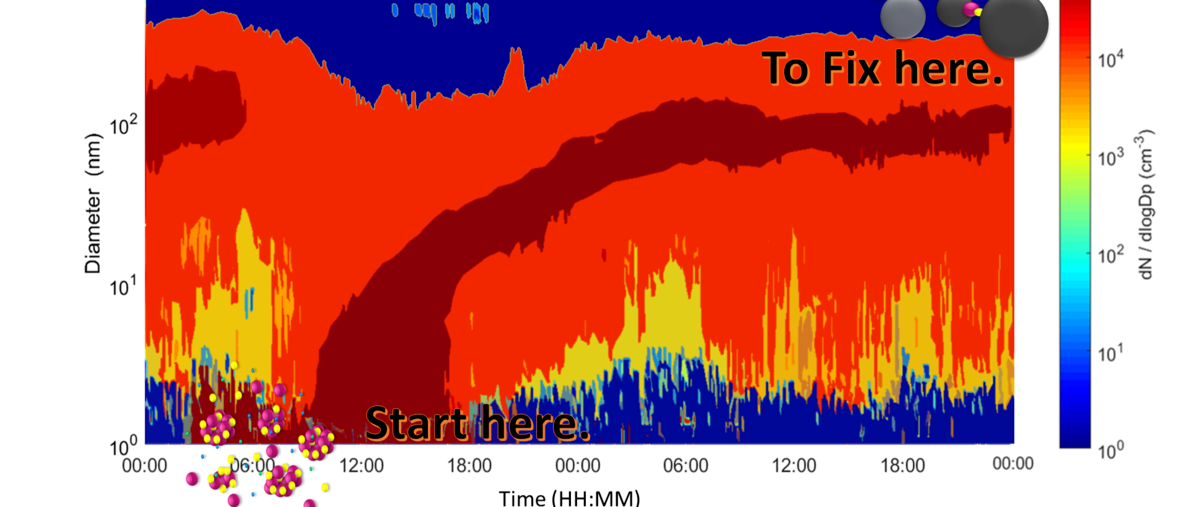Feb 24 2021
For the first time, scientists from the University of Helsinki have resolved how the ultrafine particles in the air have an impact on health and the climate.
 Researchers followed the growth and chemical composition of the freshly formed particles until those reached sizes where they contribute to mass accumulation. Image Credit: Lubna Dada.
Researchers followed the growth and chemical composition of the freshly formed particles until those reached sizes where they contribute to mass accumulation. Image Credit: Lubna Dada.
Every day, more than 10,000 people die from atmospheric air pollution. The mass buildup of atmospheric particles, measuring less than 2.5 µm in diameter, is believed to be the biggest hazard to human health, that is, if the mass and loss of visibility are higher, the threat will be bigger.
The investigators from the Institute for Atmospheric and Earth System Research (INAR) at the University of Helsinki, along with Chinese colleagues, found that if one wants to address the buildup of the largest particles, then it will be best to begin with the smallest one.
Until the latest analyses, only minimal attention had been given to the ultrafine particles, which measured less than 100 nm in diameter, because their surface area and weight are similarly insignificant. It has been debatable whether these particles can grow to pertinent sizes where they can have an impact on human health and visibility.
“We found that the smallest particles matter the most”, stated Academician Markku Kulmala from the Institute for Atmospheric and Earth System Research (INAR). The outcomes of both these studies were recently reported in the Faraday Discussion journal and Nature’s npj climate and atmospheric science journal.
Survival to Mass Relevant Sizes
When sufficient precursor vapors are available and when the conditions are conducive, particles that form in the air via gas-to-particle conversion and measure around 1 nm in diameter, suddenly appear in the atmosphere. Called New Particle Formation, this atmospheric phenomenon is seen in several different environments worldwide.
We are speaking of hundreds of thousands of particles per cubic centimeter especially in Megacities where increased population meets increased pollution.
Lubna Dada, Institute for Atmospheric and Earth System Research
The investigators addressed the long-held debatable topic of whether these tiniest particles impact visibility, haze formation, and air pollution. In a couple of parallel research works the researchers deployed the most latest and advanced instruments in the hub of Beijing to deal with “haze.”
In the first analysis, the team tracked the chemical composition and growth of the newly developed particles from sizes of approximately 1 nm until they reached sizes where they play a role in mass accumulation. This was done to figure out the reasons behind the formation and survival of these particles to mass-related sizes.
In the second analysis, the team installed advanced instruments at 260 m and at ground level and predicted the contribution of ground base sources toward the formation and accumulation of haze.
Also the Smallest Matter
These results also demonstrated that in megacities, Beijing in this example, the tiniest particles are formed from the ubiquitous gaseous sulfuric acid and amines or ammonia. These particles grow through condensation of nitrate and organics which are more or less available across the city. Although traffic and other anthropogenic activities certainly play a role in the formation of haze, the formation and growth of new particles are also significant.
To mitigate the air pollution concern and to minimize haze, the team has proposed that more attention should be given to the extremely small particles and vapors.
It´s crucial to control the precursor vapors needed to form the particles and the vapors needed to grow them.
Lubna Dada, Institute for Atmospheric and Earth System Research
A Bubble Preventing Dilution
The studies also revealed that the formation of new particles happens to be a regional phenomenon that occurs more than 100 kilometers, whereas its growth and amplification to haze-related sizes is quite local. The increased ground-level pollution along with amplified urbanization, such as high buildings, generates something like a bubble that isolates the city from the upper atmosphere.
This bubble becomes more stable if more pollution is trapped in it. This concentrates pollution within the city where humans live, and prevents the pollutants from being distributed into the upper atmosphere.
It is kind of a runaway effect—the discharge of more pollutants leads to more trapping, rendering haze even worse at ground level.
In brief, it is not only the particles that are directly emitted by anthropogenic activities such as traffic and industry need to be controlled, but also the associated vapors which are capable of forming seed particles on their own or grow those that are already present. To solve the big, we need to start small.
Lubna Dada, Institute for Atmospheric and Earth System Research
Journal Reference:
Kulmala, M., et al. (2020) Is reducing new particle formation a plausible solution to mitigate particulate air pollution in Beijing and other Chinese megacities? Faraday Discussions. doi.org/10.1039/d0fd00078g.